
# C16 - 1931 5c Rotary Pf 10-1/2x11
1931-32 5¢ Winged Globe
City: Washington, DC
Quantity: 57,340,050
Printed By: Bureau of Engraving and Printing
Printing Method: Rotary press printing
Perforations: 10 ½ x 11
Color: Violet
The Air Mail Scandal of the 1930s
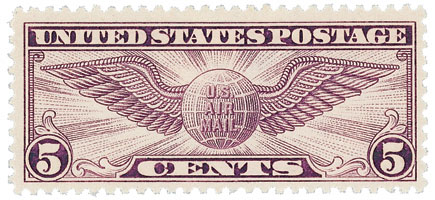
On September 28, 1933, an investigation was launched into the awarding of contracts for airmail flights. The Airmail Fiasco, as it was also known, eventually led to wide-scale improvements to the airline industry and modernization of the Army Air Corps.
The scandal had stemmed from the passage of the Air Mail Act of 1930 on April 29, also known as the McNary-Watres Act (after its sponsors, Charles L. McNary and Laurence H. Watres). The act gave the postmaster general the authority to grant long-term airmail contracts with rates based on space or volume, instead of weight.
One of the major changes this act brought about was that it changed how payments to airmail carriers were calculated. These carriers received set fees for the size of their planes, whether or not they carried mail. The goal of this provision was to discourage the carriers from bringing aboard junk mail to increase their profits. They also hoped this would help to encourage the airlines to carry more passengers.
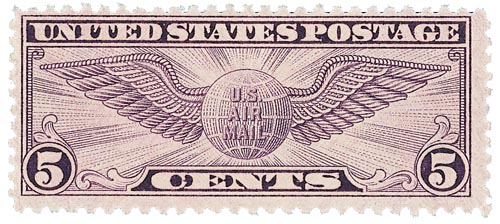
Another provision in the act permitted any airmail carriers that had a contract of two years or more to turn in their contracts for route certificates, which would allow them to carry the mail for another 10 years. The most controversial provision of the act gave the postmaster general the authority to “extend or consolidate” routes based solely on his own judgment.
In May 1930, Postmaster General Walter Folger Brown held his first “Spoils Conference.” At this conference, he called on his authority under the Air Mail Act to consolidate the air mail routes to just three major companies (that eventually became United, Trans World, and American Airlines), which were all competing. The goal of this was to force the smaller carriers to merger with the larger ones. Within two years, the airline industry was one of the only fields enjoying consistent growth and profitability, described by one historian as “Depression-proof.” The number of passengers, the distance they flew and new airline employees all tripled and airmail deliveries doubled.
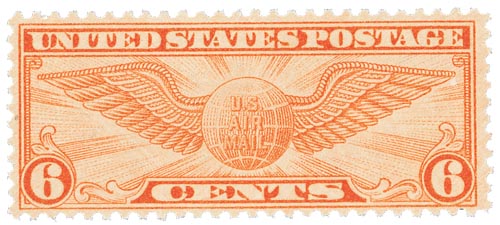
Investigation into the scandal was initially launched by journalist Fulton Lewis Jr. Lewis had spoken with an officer from the Ludington Airline. While they were the first US airline to make a profit carrying only passengers, the novelty of flying wore off during the Depression and the business suffered greatly. In 1931, they submitted a low bid of 25¢ per mile to show their commitment to extending the route “at or below cost.” Lewis later found out that not only had Ludington not received the contract, but it had gone to their rival, Contract Air Mail, at a rate of 89¢ per mile. Ludington ended up merging with another company and Lewis believed there was a scandal going on.
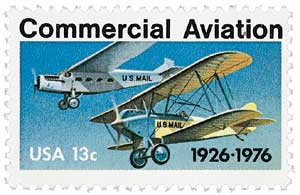
Lewis investigated the scandal and brought his concerns to the government. His concerns went largely ignored until he approached Senator Hugo Black. Black agreed something was off and launched an investigation, dubbed the Black Committee, on September 28, 1933. The Interstate Commerce Commission seized the records of all US mail carriers that day. The committee investigated a variety of concerns that airlines were scamming the system, including the padlocking of letters to make them heavier.
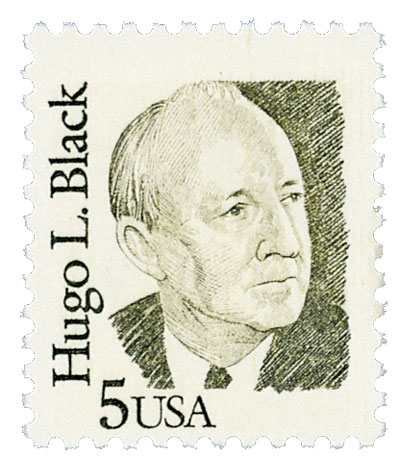
Black claimed he had found fraud and collusion between the Hoover administration and the airlines and staged public hearings in January 1934. Many of the allegations were later found to be without merit. All but two contracts had been awarded to the lowest bidder. Franklin Roosevelt’s administration sought to prevent another scandal and tasked the Army Air Corps with taking over air mail delivery. They carried the mail between February and May 1934, but suffered 66 major accidents and 13 deaths. This drew public concern leading the Air Mail Act of June 12, 1934, which reinstated competitive bidding, instituted regulations of airmail labor, shut down joint airline and aircraft manufacturing holding companies, and disallowed companies that held previous contacts from getting new ones. Though most companies simply changed names to get around this.
With airmail revenues decreasing, the airlines focused more on passenger transportation and developed new, modern planes. The Federal Aviation Commission was formed because of the act and the 1938 Civil Aeronautics Act restricted the airline industry. The Air Corps also benefited from the fallout – improving training and radio communications, flight simulators, and overall modernization, just in time for World War II.
1931-32 5¢ Winged Globe
City: Washington, DC
Quantity: 57,340,050
Printed By: Bureau of Engraving and Printing
Printing Method: Rotary press printing
Perforations: 10 ½ x 11
Color: Violet
The Air Mail Scandal of the 1930s

On September 28, 1933, an investigation was launched into the awarding of contracts for airmail flights. The Airmail Fiasco, as it was also known, eventually led to wide-scale improvements to the airline industry and modernization of the Army Air Corps.
The scandal had stemmed from the passage of the Air Mail Act of 1930 on April 29, also known as the McNary-Watres Act (after its sponsors, Charles L. McNary and Laurence H. Watres). The act gave the postmaster general the authority to grant long-term airmail contracts with rates based on space or volume, instead of weight.
One of the major changes this act brought about was that it changed how payments to airmail carriers were calculated. These carriers received set fees for the size of their planes, whether or not they carried mail. The goal of this provision was to discourage the carriers from bringing aboard junk mail to increase their profits. They also hoped this would help to encourage the airlines to carry more passengers.

Another provision in the act permitted any airmail carriers that had a contract of two years or more to turn in their contracts for route certificates, which would allow them to carry the mail for another 10 years. The most controversial provision of the act gave the postmaster general the authority to “extend or consolidate” routes based solely on his own judgment.
In May 1930, Postmaster General Walter Folger Brown held his first “Spoils Conference.” At this conference, he called on his authority under the Air Mail Act to consolidate the air mail routes to just three major companies (that eventually became United, Trans World, and American Airlines), which were all competing. The goal of this was to force the smaller carriers to merger with the larger ones. Within two years, the airline industry was one of the only fields enjoying consistent growth and profitability, described by one historian as “Depression-proof.” The number of passengers, the distance they flew and new airline employees all tripled and airmail deliveries doubled.

Investigation into the scandal was initially launched by journalist Fulton Lewis Jr. Lewis had spoken with an officer from the Ludington Airline. While they were the first US airline to make a profit carrying only passengers, the novelty of flying wore off during the Depression and the business suffered greatly. In 1931, they submitted a low bid of 25¢ per mile to show their commitment to extending the route “at or below cost.” Lewis later found out that not only had Ludington not received the contract, but it had gone to their rival, Contract Air Mail, at a rate of 89¢ per mile. Ludington ended up merging with another company and Lewis believed there was a scandal going on.

Lewis investigated the scandal and brought his concerns to the government. His concerns went largely ignored until he approached Senator Hugo Black. Black agreed something was off and launched an investigation, dubbed the Black Committee, on September 28, 1933. The Interstate Commerce Commission seized the records of all US mail carriers that day. The committee investigated a variety of concerns that airlines were scamming the system, including the padlocking of letters to make them heavier.

Black claimed he had found fraud and collusion between the Hoover administration and the airlines and staged public hearings in January 1934. Many of the allegations were later found to be without merit. All but two contracts had been awarded to the lowest bidder. Franklin Roosevelt’s administration sought to prevent another scandal and tasked the Army Air Corps with taking over air mail delivery. They carried the mail between February and May 1934, but suffered 66 major accidents and 13 deaths. This drew public concern leading the Air Mail Act of June 12, 1934, which reinstated competitive bidding, instituted regulations of airmail labor, shut down joint airline and aircraft manufacturing holding companies, and disallowed companies that held previous contacts from getting new ones. Though most companies simply changed names to get around this.
With airmail revenues decreasing, the airlines focused more on passenger transportation and developed new, modern planes. The Federal Aviation Commission was formed because of the act and the 1938 Civil Aeronautics Act restricted the airline industry. The Air Corps also benefited from the fallout – improving training and radio communications, flight simulators, and overall modernization, just in time for World War II.














